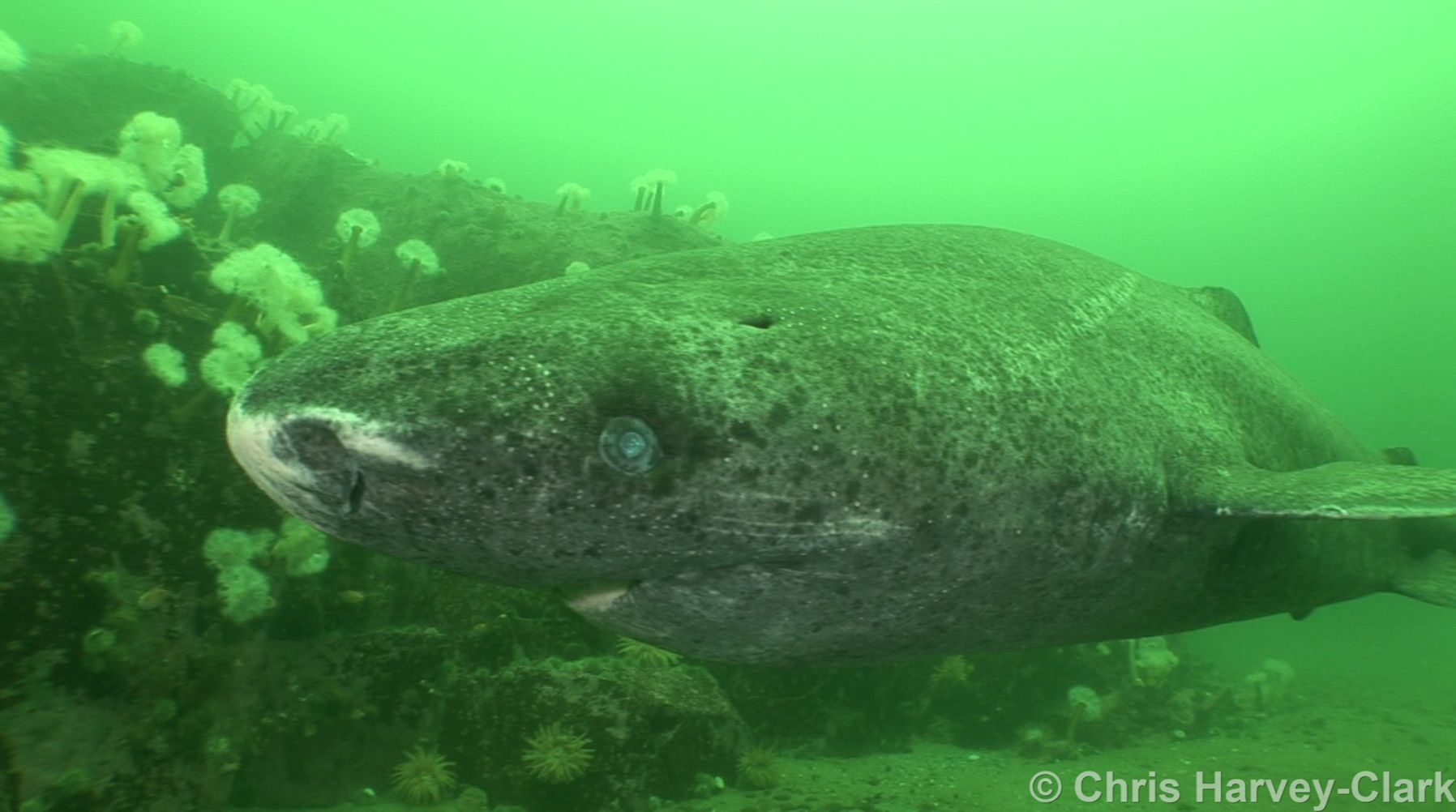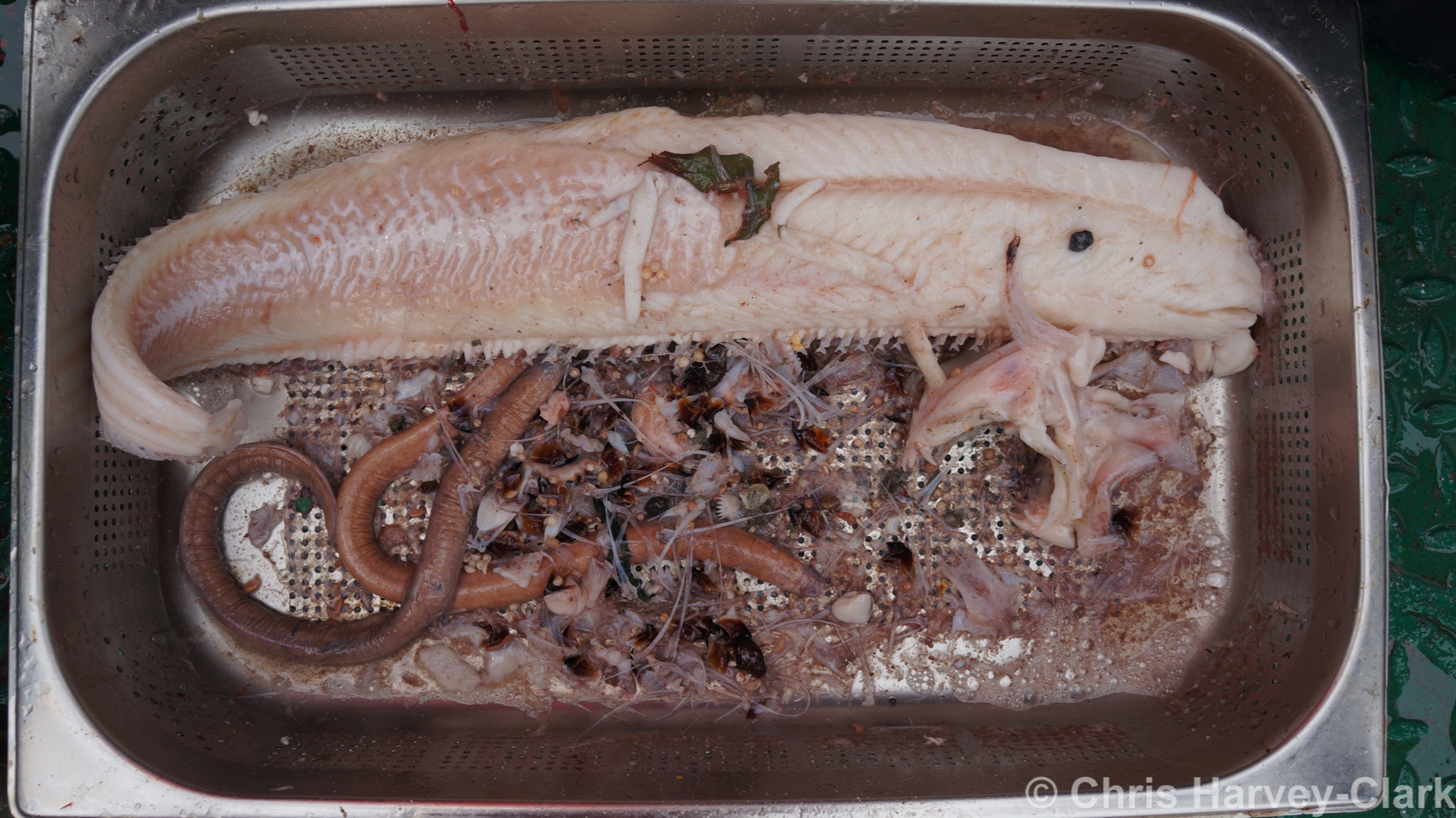Part 2: The monster revealed
The longest living vertebrate on the planet?
One of the most intriguing questions that has surrounded the Greenland shark is the mystery of its longevity. Greenland sharks until recently have defied accurate aging because their vertebrae do not form annual calcified rings, which is a feature widely used to age many species of sharks, much like the process of ring counting to age trees. Unfortunately, the vertebral ageing technique necessitates killing the shark to harvest the vertebrae. Alternately, sharks can be tagged and then recaptured to measure the growth rate, and in the 1930s the Danish researcher Paul Marinus Hansen measured and tagged a number of Greenland sharks and later recaptured a few of them. A shark tagged in 1936 and recaptured in 1952 had grown on average only 0.6 cm/year . While this is a very slow growth rate, many fish and shark species grow rapidly early in life and then reach a growth plateau at maturity, after which they continue to grow slowly. The animals in Hansen’s study were large individuals and likely had reached this asymptotic slow growth phase when measured. Many species have been kept in aquaria which has allowed measurement of growth, however captive growth experiments with this species are impractical, and the only published attempt to maintain this species in captivity was a failure after 16 days due to the shark's inability to adapt to tank barriers in captivity, where it has been found to behave more like a pelagic shark.
In addition, strange as it may seem with literally hundreds of thousands of Greenland sharks caught in the last 100 years in directed fisheries for liver oil and protein meal, there are virtually no records of gravid female sharks caught with pups in utero or newborn pups being caught. There is a single reference in the literature to a fisherman capturing a female shark which gave birth to pups as she was being landed, and the pups were in the size range of 38 cm and may not have been at full maturity in utero, as it is not uncommon for captured sharks to abort pups before they are ready for birth.
With all this uncertainty, consider what a blockbuster the August 2016 paper published in the journal Science by Danish researcher Julius Nielsen represented . He examined 28 Greenland sharks caught off the SE Greenland coast and aged them using radiocarbon dating. Examining the radiocarbon content in the lenses of the eye, which are one of the earliest structures that develop in the fetal shark with no metabolic protein turnover, thus conserving a "snapshot" of the radiocarbon levels in seawater at the time of fetal development , he established that the age of sexual maturity in this species is 156 +/- 22 years, while the median age in the animals was 272 years and the oldest animal at 5.2 m could be as much as 392 +/- 120 years. Only 3 of the 28 animals were born after the atmospheric atomic bomb test era which ended in the mid 1960s, and these animals were the smallest of his sample, in the 2 meter length range. This research supports the idea that Greenland sharks are the most long-lived vertebrates on the planet, greatly outstripping species such as bowhead whales (211 years) and the larger terrestrial tortoises, known to live up to 160 years. It is astounding to think Nielsen's 5.2 meter long shark may have been swimming the northern waters of the Atlantic in 1506, just about the time when Leonardo da Vinci was painting the Mona Lisa with an equally enigmatic smile.
Depth and temperature
Another conundrum posed by the Greenland shark is how it can survive and thrive in water that is only a degree or two above freezing, temperatures at which metabolic processes become untenable. Studies conducted by myself and colleagues have shown that the shark can live in a wide range of temperatures, from 14°C to minus 2°C, but with a marked preference for temperatures in the 2°C range. At this temperature the shark, which is "cold blooded" and lacks the ability to increase body temperature found in other shark species like the Mako, can swim and actively ingest and digest prey species such as bottom dwelling fishes and marine mammals. This is astonishing when you consider that basic biological functions like digestive enzyme activity and nerve conduction have virtually ceased at these temperatures in most vertebrate species. Combined with the fact that Greenland sharks live at crushing depths in excess of 3000 meters, where the ambient pressure is so high, in excess of 70 bar, that it can disrupt the membranes of cells, a picture of a vertebrate animal living in the most extreme conditions on the planet emerges.
One of the ways in which Greenland sharks resist extreme pressure in the deep ocean is by retaining a membrane stabilizing compound in their blood and tissues which is a nitrogenous byproduct of protein metabolism called trimethylamine oxide, or TMAO. All sharks produce urea as a relatively toxic metabolic byproduct of protein breakdown , and then must expend energy to remove the urea from their blood to excrete it in urine, spending energy in the kidney and salt gland organs to do so. TMAO is a far less toxic byproduct of metabolizing protein. High levels in the blood do not cause toxic problems for the shark, so this alternative energy pathway is important. Sharks must also regulate the levels of sodium, potassium, and chloride in the bloodstream by actively pumping out sodium and retaining potassium to closely match the percentage of these ions in the seawater they swim in . It is estimated that for many fish, a quarter to a third of all the calories that are ingested are burned just to maintain this electrolyte balance, so osmoregulation is a significant part of their energetic cost of living. Retaining TMAO in the blood stream replaces some of the osmotic pressure exerted by sodium, leads to a lower blood level of sodium and so removes some of the burden of having to continually pump out the sodium ions, with a net energy gain to the shark.
TMAO when ingested is neurotoxic and Inuit peoples shunned the shark, finding that when the flesh of Greenland shark was fed to sled dogs, convulsions, diarrhea and ultimately death would ensue, unless fermented or cooked, which appears to eliminate the TMAO. A traditional food in Iceland, hákarl, is made by fermenting and drying Greenland shark flesh, which removes the TMAO, leaving a kind of "shark cheese" with an interesting, camembert-like flavor and rubbery consistency. Together with brennivín, an anise flavored spirit distilled in Iceland, hákarl is eaten traditionally as part of the Icelandic spring celebration. Consuming Greenland shark was probably originally a "food of desperation" in the arctic regions where famine was common, and early Icelandic middens found on archeological sites frequently contain Greenland shark teeth. The teeth likewise were used, set in wood as knives and the tough, abrasive hide was used for leather.

Modes of activity and predation
Greenland sharks show an intriguing bimodal behavior pattern ; during the daytime the shark tends to stay in deeper water and spends the majority of its time cruising slowly within a meter of the bottom, moving quite slowly, at about 20 cm/second. As dusk approaches the shark begins to leave the bottom and moves up and down the water column, at times reaching near the surface, every 20 to 30 minutes. All night long the shark swims to the surface and then dives to the bottom, and as dawn approaches, remains on the bottom and stays there. What are these sharks doing? Daytime field observations of the sharks have shown that they slowly cruise over the bottom and may in fact be actively foraging while they do so, primarily on bottom dwelling fish like halibut and wolf fish, and invertebrates like crabs. These benthic , sea floor dwelling prey species are relatively abundant in the shark's range and tend to sit still, relying on cryptic coloration and lack of movement for defense rather than rapidly fleeing, which makes them easy prey for the shark's electroreception system at close range. With their giant electrosensory ampullae of Lorenzini, the sharks have little difficulty in locating and capturing benthic prey.

When conducting necropsy examination of stomach contents (often 20 percent or more of the total body weight in Greenland sharks) I have been amazed to find perfectly intact, unmarked large benthic fishes, without a bite mark or a single missing scale. The prey appears in many instances to have been consumed whole, almost as if the sharks are inhaling the prey.

In fact, it appears prey aspiration is exactly what these sharks do. In an unpublished study, researchers from Memorial University in Newfoundland deployed deep water video camera traps on metal frame stands to lure the sharks, with bait bags hanging in the center of the frame where they were inaccessible to the sharks. One video shows a shark repeatedly jamming its head into the frame and attempting to "suck" the bait bag into its mouth using its pharyngeal muscles to generate suction. Other species of sharks, notably nurse sharks, are known to use a similar suction technique to aspirate prey like lobster and octopus, literally sucking them out from holes and crevices under rocks and coral heads.

Whodunit - the mystery of the Corkscrew Killer
Establishing just how the jaws and teeth of Greenland sharks operate on their prey has had several interesting chapters involving seals. Sable Island is a seal island, a 44 kilometer long stretch of sand bar sitting 175 kilometers off the coast of Nova Scotia, sparsely inhabited by a few park rangers at a weather station. Sable is studded with shipwrecks and abandoned lifesaving stations, an outdoor museum that is home to 100 ,000 grey seals, huge colonies of ground nesting seabirds like terns, and a few hundred wild horses.
My work took me to Sable many times, and over the years of visiting Sable Island I had remarked on the number of dead juvenile seals that would wash up in the winter time. Many of the dead seals had strange, helical skin wounds that wound around the core of the bodies, as if they had been put through a giant apple peeler, and the cause of this strange wounding pattern was the subject of much conjecture. Could the Greenland shark be the cause of this strange wounding pattern? The species was certainly present in the deep waters of the North Atlantic, and had been found within 100 km of the island in a deep water area called the Sable Island Gully. But the waters around Sable are very shallow, choppy, clear and warm even in winter, well outside the normal zone of comfort for this species. The white sand bottom makes the shallows for dozens of kilometers around Sable a dazzling bright white, not attractive for a species that thrives in dark, murky water.
Matching the mystery kills of seals at Sable to potential Greenland shark predation begs the question; how does this shark actually bite and ingest large chunks of prey above the threshold of what can be "inhaled". The first photographer to film Greenland sharks underwater, Nik Caloyianis, with colleague George Benz, used a remote operated underwater camera equipped vehicle deployed on a seal carcass in deep water in the Arctic to document for the first time just how Greenland sharks go about eating a seal . An amazing sequence showed a shark approaching the prey, locking its jaws onto the carcass and then oscillating the entire body around the long axis like an auger, sawing the jaws through the prey to eventually meet, and so cutting a neatly sliced plug of tissue, rather like a giant ice cream scoop. The lesions left on the carcass are very characteristic and resemble a large concave bowl with a "Figure 8" appearance to the clean cut edges that correspond to the upper and lower jaws. Few sharks species other than sleeper sharks like the Greenland shark, sixgill, sevengill and cookie cutter sharks have the necessary teeth and jaw specializations to create this type of lesion. Yet the mystery remained - what was causing the corkscrew lesions on seals at Sable Island?
In July 2010 I received an email message from Dr. Steve Bexton, a UK based wildlife veterinarian who had been encountering dead adult seals with helical skin lesions very similar to the ones I had been seeing at Sable Island, on dead Grey seals washing up on the Devon Coast in England. He had read my publications on Greenland sharks and was eager to discuss whether this species might be the cause of the strange injuries he was observing. In the course of our conversation I shared with him my observations of the morphology of Greenland shark skin wounds on seals and that I was not convinced this species was the cause of the helical injuries. Bexton went one better; he had been able to suture the injuries back up again and had thus demonstrated a lack of any tissue loss in several of the victims. We agreed it would be very odd for a shark not to take tissue from a kill of this kind. Puzzled by the mystery, I continued to look into possible causes for the strange "corkscrew" lesions, suspecting that a man made cause like a propeller seemed the likely culprit.
Through my contacts in human pathology I explored the case reports and scientific literature on human injuries caused by propellers. This proved initially fruitless, with injuries resembling a series of parallel knife cuts, nothing like what we were seeing in the seals. I began to wonder if another predatory species, not the Greenland shark, was involved. Then I had a breakthrough. In an obscure Japanese forensic pathology journal, grisly images showed human torsos from fishermen who had been run over by traditional Japanese motorised fishing boats, with long helical slashes to the torso, very similar to what was seen in the seals. This was caused by the unusual propellers used by these boats, a three bladed, very large diameter, slow rotating propeller that would entrain the body of the victim within the propeller hub and caused the rotational and shearing injuries that resulted in helical wounds.
I shared these findings with Bexton, who had come to the same conclusion - the injuries were likely man made. Subsequently he found the "smoking gun", a seal that actually had the star shaped imprint of a line cutter on its muzzle, a special blade on the propeller hub designed to cut line wrapped around a prop. There were no Japanese fishing vessels with slow RPM propellers either in Devon or at Sable Islands but both sites had another type of vessel operating that could explain the lesions. Sable Island had numerous oil wells regularly serviced by supply ships, and Devon had recently seen the construction of a large offshore wind farm using pile driving vessels. Both types of ships had the requirement to stay in one position on a target location very accurately while working, and this was achieved using a DPS or Dynamic Positioning System. DPS vessels use a series of small computer controlled underwater thruster motors which work intermittently to keep the vessel within a meter of a designated position. The thrusters use a directional nozzle propeller called a Kort thruster, which generates tremendous negative pressure and can suck in objects a long way from the propeller, like a seal. Subsequently the Sea Mammal Research Unit, University of Aberdeen, conducted a series of experiments and published findings that implicated the Kort nozzle as the cause of the seal deaths .

So it appeared in this case the Greenland shark was exonerated, and the "corkscrew killer" case as styled by the media was solved - the culprit in fact was marine industry. I held this belief until late in 2016 when a Scottish seal researcher observed and published a ghoulish set of field observations. Working at a seal colony, he saw a single "rogue" male grey seal repeatedly attack, drown and then consume portions of juvenile grey seal pups, mostly the subcutaneous fat over the back area. The skin wounds caused by the male seal were helical shaped lesions…very similar to those seen on the juvenile seals kills at Sable Island . Greenland shark, Kort nozzle, or cannibalistic infanticide, the possible cause of strange corkscrew lesions on juvenile grey seals in the North Atlantic remains moot.
Orcas who don’t floss: dental wear and shark predation
In July 2008 I was conducting a research dive at one of the Greenland shark sites near Baie Comeau, Quebec, a deep bay called Baie des Anglais, where we had seen a number of sharks that season. It was a sparkling sunny day and as we ran the inflatable boat to the mooring a whale surfaced and blew a characteristic v shaped blow a hundred meters off the bow. The whale was a local celebrity, a big male sperm whale (Physeter macrocephalus) named Tryphon, well known for years by whale watchers up and down the St Lawrence, who had been in the area for a week. As we suited up to dive we saw several more blows a few hundred meters out in the bay, and I wondered whether we might get some underwater glances of this amazing creature. We rolled into the water and descended to the sloping sandy bottom, following the contours down to 40 m where it was very dark and the visibility was perhaps 5 meters. After swimming a standard transect at the site we had just turned the dive and were headed up slope towards shallow water when out of the gloom rushed a 4 m female Greenland shark, swimming unusually rapidly right past us towards deep water. I cranked up the camera and we chased her briefly to try and get identifying video but she was moving too fast and it was too deep to follow her. Strangely, I noticed her mouth was gaping, her pharynx was distended and her gill slits were wide open. After reflecting a few moments I realized that this was a unique observation: the first documented instance of ram ventilation in a Greenland shark. Ram ventilation is a phenomenon usually associated with fast moving, high metabolic rate sharks like makos and Great whites, seen during burst speed swimming. In order to extract the extra oxygen needed for the aerobic demands that high speed requires, the shark opens the mouth while swimming, ramming a large volume of well oxygenated seawater over the gills. This is logical in a high speed predator like a mako, but to see a Greenland shark, as a rule a slow swimming, slow metabolism type of shark, ram ventilating was highly unusual and unexpected - like finding a racing stripe on a snail. We watched the shark as it rapidly disappeared into the gloom and finished the dive without further incident.
Some months later I reviewed field research tapes from that summer and watched the video on a monitor with a high fidelity sound system. As I watched the female shark racing past I noticed a distinct sound on the sound track, spaced at 10 second intervals, a "tock" sound that was almost mechanical. Taking the sound track to Dr. Hal Whitehead, an authority on acoustic biology of sperm whales, I learned that the sound was a whale echolocation click series that is usually heard when sperm whales forage, basically a hunting click. That this hunting click by the whale was associated with a fast swimming Greenland shark ram ventilating, something we had never seen before, seemed a remarkable coincidence. Although in science the rule is that association is not necessarily causation, hunting whales and fleeing sharks seemed more than coincidental and led me to research the feeding habits of sperm whales. Two references confirmed that sperm whales have been found with the remains of Greenland sleeper sharks in their stomachs, which makes an interesting conclusion to this irreproducible event. It appears that the whale may well have been on the track of the Greenland shark we had seen, which was fleeing at high speed and ram ventilating to accommodate the extra aerobic demand.
The phenomenon of toothed whales like sperm whales and orca predating sharks has been characterized in recent years, with several scientific publications and numerous YouTube videos of orcas preying on and even passing around and playing with the carcasses of great white sharks.
Scientists have long been aware of two distinctive populations of orcas found on the west coast of North America. "Resident" orcas are found primarily in the Southern Gulf Island’s region between Washington State and British Columbia and are salmon eaters, with cone like, blunt teeth, while "transient" orcas range all over the Pacific coast as far as Hawaii and Alaska and down to Mexico, and are primarily marine mammal predators with curved, sharper, teeth. Researchers had puzzled for a long time about a third phenotype of orca, known mostly from jaws and teeth in museum collections. These orcas, called "offshore" orcas, tend to travel offshore in large groups within the boundaries of the continental shelf and, inexplicably, have flattened teeth that are peg-like stubs.

Why were the teeth of these orcas so extremely worn - as one researcher put it, perhaps they weren’t flossing? The mystery of the worn out teeth was finally addressed in 2011 when a group of researchers pursuing an offshore orca group in Hecate strait north of Vancouver Island , Canada, made a startling discovery. The orcas would disappear on long dives, during which odd, purple colored lumps of soft material came floating to the surface. When these lumps were taken back to the lab and examined, DNA content revealed the day's catch was in fact the livers of no fewer than 8 Pacific Sleeper Sharks, Somniosus pacificus, a close relative of Somniosus microcephalus, the Greenland shark . Why would the orcas target this shark species? Sleeper sharks have up to 20 percent of body mass in liver tissue, and the 100 kg liver of a single 500 kg sleeper shark would provide the day's ration for several adult orca. Compared to the awe inspiring hunting skills of orca, a slow moving sleeper shark is nearly defenseless, and so with motive (hunger) and opportunity (easy nutritious prey) it is not hard to appreciate why offshore orca may specialize in predating sleeper sharks. For orca, the major down side in this uneven match is the sandpaper skin of the sharks, which causes the tooth wear seen in the offshore population. Dental attrition in turn likely limits the life expectancy of offshore orcas to a few decades, where we know resident orcas may live over 100 years.
The dental wear of whales' teeth due to shark predation leads back to the sperm whale Tryphon, possibly the nemesis of Greenland sharks in the region where I have studied this species since 2003. Sadly, in 2009 Tryphon died, ensnared in fishing gear near Sept Iles, Quebec. The necropsy results included photos of Tryphon's teeth, which were worn to flattened stubs, closely resembling the teeth of offshore orcas, quite unlike the normal, cone shaped teeth of this species. This final discovery supports the theory that Tryphon may have been targeting Greenland sleeper sharks near our study site.
The mystery remains
No one has seen Greenland sharks breed or give birth, in fact there is only a single reference documenting a pregnant Greenland shark. Considering that Greenland sharks swim under the polar ice cap, and that their almost indistinguishable relative, the Pacific sleeper shark, roams the far northern waters of the Bering sea and into the Beaufort sea, is it possible that the range of these two species could overlap? An intriguing finding in 2015 came about as part of the research following the Gulf Horizon oil spill, when researchers found that a Greenland shark collected from 2500 m in the Gulf of Mexico had genetic evidence of hybridization between the two species, approximately 18 percent genetic homology with the Pacific sleeper. It is intriguing to think of the deep water tryst between the two species that might have resulted in this hybrid, particularly given their cannibalistic tendencies. Despite their relative abundance in Arctic waters, the mystery of where and how Greenland sharks reproduce, and the fact that there are only a few references to sharks less than 2 m total length, is the ultimate riddle of this enigmatic species. Where are the pregnant females? Where are the baby and juvenile sharks? With this, and a number of other mysteries, an un-named monster of the deep, the enigmatic Greenland shark, will continue to fuel the imagination of man for a long time to come.
See also the first part of this essay on the Greenland shark:
 Zoology
Zoology
Responses